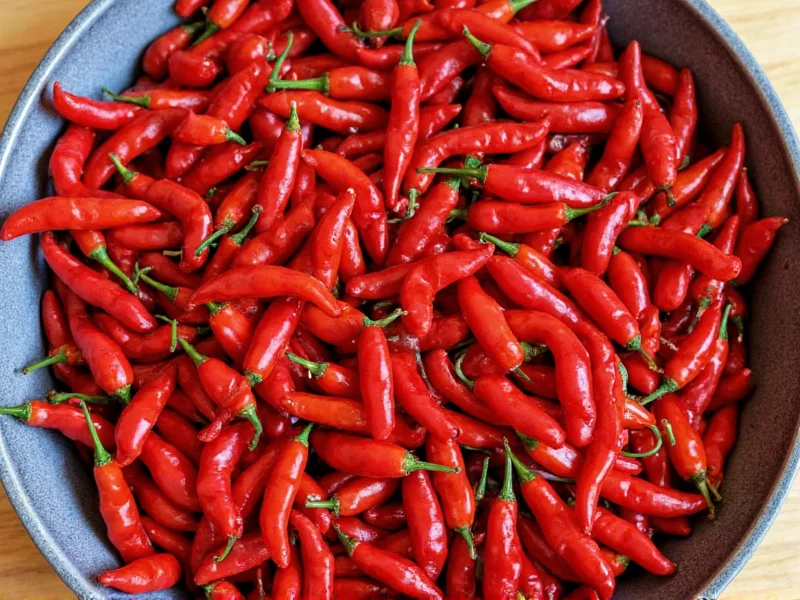Ancho chiles, the dried form of poblano peppers, represent one of Mexico's most beloved culinary ingredients. Understanding their precise heat level helps home cooks and professional chefs alike create balanced dishes that showcase their complex flavor profile without unexpected spiciness.
What Exactly Are Ancho Chiles?
Ancho chiles are fully ripened poblano peppers that have been dried. The name "ancho" means "wide" in Spanish, referring to their broad, flattened shape. When fresh, these peppers are called poblanos; after drying and turning deep red-brown, they become anchos. This transformation concentrates their flavor while maintaining a relatively mild heat profile.
Understanding the Scoville Scale
The Scoville scale measures chili pepper heat by determining capsaicin concentration—the compound responsible for spiciness. Developed by pharmacist Wilbur Scoville in 1912, this scale assigns Scoville Heat Units (SHU) based on how much sugar-water dilution is needed to neutralize the heat.
Ancho chiles' position at 1,000-2,000 SHU places them significantly milder than many common peppers. For context, this heat level is comparable to what you'd experience from a very mild banana pepper or a sweet bell pepper with just a hint of warmth.
Comparing Ancho Heat to Other Popular Peppers
| Pepper Type | Scoville Heat Units (SHU) | Heat Comparison to Ancho |
|---|---|---|
| Ancho Chile | 1,000-2,000 | Baseline |
| Bell Pepper | 0 | 0-50% as hot |
| Poblano (fresh) | 1,000-2,000 | Same heat level |
| Guajillo Chile | 2,500-5,000 | 2-3x hotter |
| Jalapeño | 2,500-8,000 | 3-8x hotter |
| Serrano | 10,000-23,000 | 8-20x hotter |
| Habanero | 100,000-350,000 | 75-300x hotter |
Factors That Influence Ancho Chile Heat
Several variables can affect how hot your ancho chiles might taste:
- Growing conditions: Soil quality, climate, and water availability impact capsaicin production
- Ripeness at harvest: Fully mature red poblanos yield slightly hotter anchos than those picked earlier
- Seed and membrane content: Removing seeds and white ribs reduces heat significantly
- Storage duration: Heat diminishes gradually over time as capsaicin breaks down
- Individual sensitivity: Personal tolerance to capsaicin varies considerably between people
Culinary Applications of Ancho Chiles
The mild heat of ancho chiles makes them exceptionally versatile in cooking. Their primary contribution is complex flavor rather than intense spiciness. Chefs value anchos for their:
- Deep, slightly sweet flavor with notes of dried fruit, coffee, and tobacco
- Ability to add depth to sauces without overwhelming heat
- Excellent performance in slow-cooked dishes where flavors meld together
- Compatibility with chocolate in traditional mole sauces
- Rich red color that enhances visual appeal of dishes
When rehydrating dried anchos for recipes, simply soak them in hot water for 15-20 minutes until pliable. The resulting liquid can be strained and incorporated into sauces for additional flavor dimension without adding significant heat.
Common Misconceptions About Ancho Heat
Several misunderstandings persist about ancho chile heat levels:
- Confusion with mulato chiles: Mulatos are often mistaken for anchos but are actually dried mulato peppers (a different variety) with slightly different flavor and comparable heat
- Assuming all dried chiles are hotter: Drying concentrates flavor but doesn't necessarily increase heat proportionally
- Expecting uniform heat: Natural variation means one ancho might be noticeably milder than another from the same batch
- Mistaking flavor intensity for heat: The robust, complex flavor of anchos can be misinterpreted as spiciness by those unfamiliar with them
Practical Tips for Cooking with Ancho Chiles
Maximize your experience with these mild yet flavorful peppers:
- Toast dried anchos lightly in a dry skillet before rehydrating to enhance their natural sweetness
- Remove seeds and white membranes if you prefer even milder heat in your dishes
- Blend rehydrated anchos with other ingredients rather than using them alone for balanced flavor
- Store dried anchos in an airtight container in a cool, dark place for up to one year
- Consider anchos as a flavor base rather than a primary heat source in your recipes
Why Ancho Chiles Are Perfect for Beginners
For those new to cooking with chiles, ancho peppers represent an ideal starting point. Their mild heat level allows cooks to experiment with authentic Mexican flavors without the risk of creating inedibly spicy dishes. The forgiving nature of ancho chiles makes them perfect for family meals where varying heat tolerances exist among diners.
Professional chefs often recommend anchos to novice cooks exploring Mexican cuisine because they provide authentic flavor without the intimidation factor of hotter peppers. This accessibility has contributed significantly to their popularity in both traditional and fusion cooking worldwide.











 浙公网安备
33010002000092号
浙公网安备
33010002000092号 浙B2-20120091-4
浙B2-20120091-4